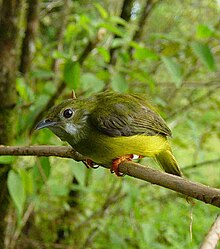Pipridae
| Manakins | |
|---|---|
 |
|
| Juvenile white-collared manakin | |
| Scientific classification | |
| Kingdom: | Animalia |
| Phylum: | Chordata |
| Class: | Aves |
| Order: | Passeriformes |
| Suborder: | Tyranni |
| Family: |
Pipridae Rafinesque, 1815 |
| Species | |
|
Many, see text |
|
 |
|
| Manakin range | |
Many, see text
The manakins are a clade (Pipridae) of small suboscine passerine birds. The group contains some 60 species distributed through the American tropics. The name is from Middle Dutch mannekijn "little man" (also the source of the different bird name mannikin).
They range in size from 7 to 15 cm (3 to 6 in) and in weight from 8 to 30 g (0.28 to 1.06 oz). The genus Tyranneutes comprise the smallest manakins, the genus Antilophia are believed to be the largest (since the Schiffornis genus are no longer considered manakins). They are compact stubby birds with short tails, broad and rounded wings, and big heads. The bill is short and has a wide gap. Females and first-year males have dull green plumage; most species are sexually dichromatic in their plumage, the males being mostly black with striking colours in patches, and in some species having long, decorative tail or crown feathers or erectile throat feathers. In some species, males from two to four years old have a distinctive subadult plumage.
The syrinx or "voicebox" is distinctive in manakins, setting them apart from the related families Cotingidae and Tyrannidae. Furthermore, it is so acutely variable within the group that genera and even species can be identified by the syrinx alone, unlike birds of most oscine families. The sounds made are whistles, trills, and buzzes.
Manakins occur from southern Mexico to northern Argentina, Paraguay, and southern Brazil, and on Trinidad and Tobago as well. They are highly arboreal and are almost exclusively forest and woodland birds. Most species live in humid tropical lowlands, with a few in dry forests, river forests, and the subtropical Andes. Some highland species have altitudinal migrations.
...
Wikipedia
